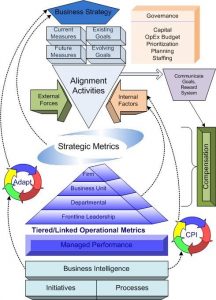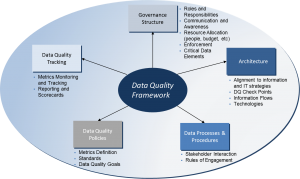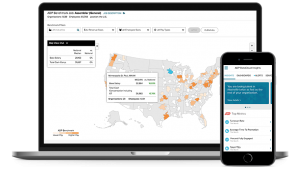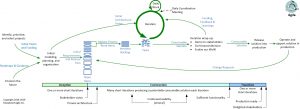Data Analytics Capabilities
Organizations that lack data cannot navigate the modern world. Once data is synthesized into actionable information it empowers organizations to act decisively and intelligently. Our experience in validating strategies, providing situational awareness and accumulating knowledge from unstructured data has proven valuable to clients across industries.
Actionable Strategies equips organizations to apply data to run more effectively and with greater agility. Sustainable data foundations require governance, processes, data quality management and pragmatic use of technologies. We apply our experience with real-time data, data warehouses, analytical visualization and predictive models in a strategic context. Our approaches enable clients to turn data into information that drives success with increasing long-term performance.
 The client is a $1.1B publicly traded REIT that acquires, manages, expands, and develops office and laboratory space properties. Data analytics were required by all of the stakeholders, particularly investment, construction, finance and accounting, and senior executives.
The client is a $1.1B publicly traded REIT that acquires, manages, expands, and develops office and laboratory space properties. Data analytics were required by all of the stakeholders, particularly investment, construction, finance and accounting, and senior executives.
After successfully delivering a data warehouse and Essbase analytics project, we continued to deliver against the data analytics roadmap that we defined. Applying Agile techniques from program management through to product development, yielded business results in 6 months. The roadmap continued to deliver further analytical capabilities with a predictable cadence.
Business Problem
The business lacked visibility because of the lack of information. The legacy ERP system provided some raw transactional reporting but this was backward looking and had to be manually manipulated in Excel to produce usable information. At the root of this problem was the lack of a data foundation and applications to deliver the right information to the right people at the right time.
Solution Approach
 Rather than attempting a major data warehouse initiative, we applied an agile approach. We still utilized good project management practices and developed a program charter which obtained buy-in from senior leaders across the enterprise.
Rather than attempting a major data warehouse initiative, we applied an agile approach. We still utilized good project management practices and developed a program charter which obtained buy-in from senior leaders across the enterprise.
Data Warehouse Pilot
The first project in the program delivered analytical capabilities for finance. As a publicly-traded REIT it was essential that financial reporting be both accurate and timely.
Key elements of the pilot, which became best practices for future projects:
- Scope control
- Agile approaches AND strong project management
Successful Project
Once the pilot garnered excitement, our mandate to drive the program forward was solidified. While the
client was concerned about results rather than the Agile techniques used, they were critical to rapid success.
Evolutionary Program
 Continuing with the Agile approach, the next steps in the program were defined. Once again, we applied solid program management practices and actively engaged both stakeholders and detractors to maintain alignment and reduce resistance.
Continuing with the Agile approach, the next steps in the program were defined. Once again, we applied solid program management practices and actively engaged both stakeholders and detractors to maintain alignment and reduce resistance.
The next detailed part of the roadmap delivered high value analytics that were achievable. For long running programs, our objective is to establish a steady state that can be brought in-house and managed by the client.
Key Challenges
The program was faced with a number of key challenges. While data modeling was difficult, it was completed in a timely fashion. The relative immaturity of the organization with respect to data and analytics posed several constraints.
Master Data Management
We had to educate the client around data modeling and master data. They were very receptive and agreed to add a separate project to address their issues with master data.
Data Quality
The presumption by the client that data was clean eventually eroded as rapid prototypes revealed data quality issues.
Entitlements
As a publicly-traded company, the client had many data assets to protect. Developing an entitlements model was time-consuming but necessary. The model was propagated back into HR and IT processes.
Requirements
Unaccustomed to enterprise programs, the client had difficulty reaching consensus. Being pragmatic, we delivered building blocks such as dashboard components which could then easily be rolled up into enterprise-wide business views.
Business Results
Applying Agile techniques combined with pragmatic program and project management discipline quickly delivered tangible business results. This established the foundation for a data analytics program that grew in functionality and footprint to include Oracle Business Intelligence. Subsequent business projects began delivering value based on a solid and expanding foundation. Knowledge transfer, documented and automated processes, and extensive collaboration enabled the client to move rapidly up the maturity curve. This facilitated an eventual transition to in-house teams.
 Evolving market conditions in all industries have brought the need for insight into the business into much sharper focus. By applying Lean principles to attaining better insight, organizations achieve high impact results.
Evolving market conditions in all industries have brought the need for insight into the business into much sharper focus. By applying Lean principles to attaining better insight, organizations achieve high impact results.
- Strategic alignment of measurements
- Performance management driven by results
- Strategic insight into the enterprise
- Agility in execution to drive immediate value
Actionable Strategies applies a strategic framework to ensure that the front-line delivery aligns to business objectives. Simple end user business intelligence tools often rely on incomplete, incongruous or incorrect data. The focus of enterprise BI is on delivering correct data in a consumable form at different levels of the organization.
This industry leading company provides processing of HR data and outsourcing on a global basis. It has amassed the largest independent data sets encompassing just under a million companies and over 30 million people. Despite having 60 years of history, the company was lagging smaller competitors in the area of analytical capabilities.
Actionable Strategies built the foundational organization, processes and technology models used by the client today to provide products, solutions and advisory services to their customer base. The initial data science work enabled the client to understand what assets could be delivered to the market and also used internally.

Solution Approach
An evolutionary approach enabled the client to move from Plan and Pilot activities to the Growth stage.
- Pilot deployment delivered initial capabilities to support exploration by data scientists
- Initial exploration supported pilot product development and led to an initial release of an analytics product
- Subsequent efforts led to a structured data repository supporting sustainable product development and exploration by internal users
Key Technology Approaches
A sustainable model was established and built incrementally.
- Shared Hadoop Data Lake for all stakeholders
- Anonymized personally identifiable information, protecting privacy and avoiding data spills
- Aggregation of data for privacy but also to facilitate very fast analytical performance
- Common interfaces (e.g., JSON) to enable product development across platforms
- Support for enterprise standard toolsets (R, Oracle, Cognos, D3, HighCharts) and end-user exploration tools (Cognos, Tableau, Microsoft Power BI and Excel)
Initial data science work evolved into delivering a mature data science foundation used by different stakeholders with varying technical skills.
 This global real estate firm invests in best-in-class campuses for science and technology in the most desirable urban locations. Their total market capitalization is $11.1 billion and they operate an asset base of over 25 million square feet with 6 million square feet of new development in the pipeline.
This global real estate firm invests in best-in-class campuses for science and technology in the most desirable urban locations. Their total market capitalization is $11.1 billion and they operate an asset base of over 25 million square feet with 6 million square feet of new development in the pipeline.
As executive and front-line leadership grew more sophisticated in the needs for analytics, data quality issues arose as more advanced visualizations increased the consumption of data cross the organization. Quality issued had been previously masked as data tended to remain in operational silos such as ERP, with summarized information used for decision-making.
Situation
The client uses an enterprise resource planning platform to house data for every major function of the business. However, each function produced and consumed data as appropriate for their individual use. Major functions such as investments, asset management and financial reporting treated information in very different fashions.
As executive and front-line leadership grew more sophisticated in the needs for analytics, data quality issues arose. These had been previously masked as data tended to remain in operational silos with summarized information used for decision-making.
Approach
Actionable Strategies dealt with initial resistance to acknowledging data quality issues. We have found this to be commonplace as data may be fit-for-purpose but not usable as-is in the enterprise.
Data governance: Data governance was not in place and needed to be established using Actionable Strategies’ proven framework.
Data owners: One foundational activity was to establish data owners who “produce” information for others to consume. Their upstream position in the information value chain empowers them to maintain data quality while obligating them to produce it in a fashion that conforms to downstream use. Individual contributors were educated on how their data was consumed and how to execute data quality processes.
Data stewards: Data stewards with subject matter expertise were identified. They were educated in the relevant value chain, which included both process and data knowledge. At this particular client, they were empowered to directly affect operational change to maintain data quality on behalf of data owners.
Data quality processes: Effective procedures were established to ensure data quality. While many of these were supported by technology, many manual processes persisted. Data quality checks were embedded into operational processes. These data quality checks provided metrics and reports to data owners who then acted to remediate quality problems.
Architecture: An architecture that met immediate and future data quality needs was defined. This included automation of workflow and data ingestion.
Results
Known data quality issues were quickly remediated allowing data to flow into multiple analytics platforms. Data quality problems were detected upstream and addressed as identified compared to months of lag time for discovery and eventual remediation. While larger data sets were surfaced, compliance was simultaneously improved, including:
- Protection of personally identifiable information (PII)
- Protection of protected health information (PHI)
- Security around non-public financial data
- Security around proprietary and confidential data
- Integrity of operational, financial and management data
 This early stage media company sought to change media planning and buying by providing detailed purchasing behavior built at the household level. This would provide advertisers precise impact and target control by a large universe of demographic factors. The company used models that determined which household members viewed programming and advertisements. By linking the demographic data to purchase data, it was able to determine the relative effectiveness of ads on purchasing. The challenge was turning an idea into a profitable and scalable business.
This early stage media company sought to change media planning and buying by providing detailed purchasing behavior built at the household level. This would provide advertisers precise impact and target control by a large universe of demographic factors. The company used models that determined which household members viewed programming and advertisements. By linking the demographic data to purchase data, it was able to determine the relative effectiveness of ads on purchasing. The challenge was turning an idea into a profitable and scalable business.
As a result of the successful product launch, the client grew as a leader in the field. Eventually, it was purchased by a large media player leading to a highly successful and profitable exit for investors.
Initially, consultants helped the client navigate business issues related to launching a new product. Subsequently the significant technical challenges posed by the volume and frequency of data were addressed. Ingesting terabytes of real-time click data from millions of set-top boxes posed unique constraints on both technology and operating processes.
The work transitioned through the following phases:
- Business and Technology Strategy
- Product Management
- Scalable Operating Model
- Lean Product Development
- Information and Data Quality Management
- Analytics and Product Development
After initial product launch, consultants continued to refactor and add features to the product. Agile software development processes were used from the onset with great success.

Iterative development and the addition of new features continued until the company was acquired.
 The client is a Fortune 500 company and provider of business process outsourcing and human capital management solutions. The company has revenues of $12B from 700,000 clients in 112 countries.
The client is a Fortune 500 company and provider of business process outsourcing and human capital management solutions. The company has revenues of $12B from 700,000 clients in 112 countries.
After conducting a strategic competitive analysis, Actionable Strategies was subsequently tasked with defining a product strategy for delivering products that provide predictive analytics. The client then asked us to build the initial product which won “Top HR Product” in HR Executive Magazine.
 Product Strategy
Product Strategy
To remain competitive with new entrants into the market, the company wanted to provide more advanced capabilities as part of their current product sets. Our competitive analysis and market research demonstrated a willingness to pay for advanced analytical capabilities. We utilized our Lean Product Development approach for the project lifecycle.
Product Development
Actionable Strategies worked with the client to identify predictive measures and other meaningful analytics and turn them into product offerings.
- Predict turnover in different parts of the business and determine potential actions
- Show how business measures of costs and revenue loss related to human capital factors such as attrition and overtime
- Align compensation with market measures including by geography
- Provide flexible views of workforce demographics
- Recruit effectively by providing insight into compensation and other metrics
- Analyze turnover, tenure, retention and other key indicators across different views of the business
Software Development
 Essentially, Disciplined Agile Delivery was followed. Keys to success and other takeaways include:
Essentially, Disciplined Agile Delivery was followed. Keys to success and other takeaways include:
- Actionable Strategies conducted market research and competitive analysis to determine potential projects.
- New work items (stories) were added as part of the Lean Product Development process described above.
- The architecture served JSON objects to the browser, but used sample data until the middle tier could be built to transform cleansed production data.
- Evolving the WoW (way of working) involved reducing the iteration length to 1 week with the Chinese development team working late at night to collaborate with U.S. product stakeholders.
- The infrastructure evolved with all data and servers eventually moved into a Tier 1 production data center.
Results
Actionable Strategies collaborated closely with business and marketing leaders to conceive and build the product.
- The initial prototypes were well received by key customers, when previewed at trade shows, and to the press
- After formally launching the product, the client received the “Top HR Product” award by HR Executive Magazine
- The client immediately realized sales and testimonial customers from the enterprise segment of their business
- Actionable Strategies fully transitioned the Agile software development operation to the client IT organization when it was ready, from story cards to automated testing
- The client continued to extend the capabilities of the product into the mid-market segment, which is the most profitable area of their business
Today the client has a broad product offering and has elevated data delivery and analytics capabilities in their product and services mix.
 The client is a global real estate services company that operates a portfolio of properties and development projects. It is fully-integrated, developing and managing premier assets focused on the tenant experience.
The client is a global real estate services company that operates a portfolio of properties and development projects. It is fully-integrated, developing and managing premier assets focused on the tenant experience.
The company has $202B in assets and 19,000 employees managing over 600 properties. 30 more projects, comprising 40M square feet, are under development. The portfolio contains 450M square feet of commercial properties, over 17,000 apartments and 170 retail destinations.
Actionable Strategies was engaged to manage a program to deliver a data warehouse, business intelligence and data governance while improving PMO capabilities.
Client Profile
 The client is a global real estate services company that operates a portfolio of properties and development projects. It is fully-integrated, developing and managing premier assets focused on the tenant experience.
The client is a global real estate services company that operates a portfolio of properties and development projects. It is fully-integrated, developing and managing premier assets focused on the tenant experience.
The company has $202B in assets and 19,000 employees managing over 600 properties. 30 more projects, comprising 40M square feet, are under development. The portfolio contains 450M square feet of commercial properties, over 17,000 apartments and 170 retail destinations.
Services include:
- Business & Capital Planning
- Property Management
- Leasing
- Marketing
- Development
- Design & Construction
- Arts & Events
Business Objective
 Executive leadership did not have a clear picture of the company across global regions. The CIO engaged Actionable Strategies for our expertise in real estate, program management, data warehousing and data analytics. The objective was to drive a program to deliver a data warehouse and initial business intelligence functionality.
Executive leadership did not have a clear picture of the company across global regions. The CIO engaged Actionable Strategies for our expertise in real estate, program management, data warehousing and data analytics. The objective was to drive a program to deliver a data warehouse and initial business intelligence functionality.
Stated Constraints
 The CIO had a firm grasp of the constraints that would be faced.
The CIO had a firm grasp of the constraints that would be faced.
- Business re-prioritization and evolving international initiatives required agility
- Close coordination with a maturing PMO was required including guidance in best practices
- Deliverables and interim work products were being scrutinized by senior executives requiring polished and succinct reports that summarized the detail provided by the project teams
- Managing the implementation vendor was a high visibility item due to past issues experienced by the client
- Internal capacity was already overcommitted requiring Actionable Strategies managers to “roll up their sleeves” with data and business intelligence work
- This was the first end-to-end initiative for the IT Director responsible for the program
Solution Approach
 Managing the program required that we identify work streams not part of technical implementation. While the client considered some of the additional effort, there were a number of critical sub-projects that were critical to success.
Managing the program required that we identify work streams not part of technical implementation. While the client considered some of the additional effort, there were a number of critical sub-projects that were critical to success.
Data Governance
Data Governance was essential to immediate and future success. The implementation vendor was responsible for creating a data dictionary and logical data design. A reasonable target of one year was negotiated. However, the numerous legacy systems with known data quality issues necessitated creating a separate data governance project.
Composite Data
Data analytics was viewed as a strategic program with enduring value. The long term model included data beyond the operational realm. This included a number of domains outside of the scope of the initial data warehouse.
This required planning for an extended data model, ingestion of data and ongoing data quality management managed by defined data governance. Additional data sources included:
- Corporate data required for more strategic reporting
- Occupants’ demographic and other master data overlays
- External financial data about tenants and their parent organizations
- Lease information not previously captured in structured data models
- Metrics related to tenants, leases, properties and geographies
Data Quality Management
 While individual departments understood that there was dirty data in their reporting, an overall plan needed to be enacted to ensure that strategic reporting would be accurate on a consistent basis. Data quality management was initiated as a longer term initiative. After initial data cleansing, an ongoing operational effort was defined to ensure that strategic reporting remained effective.
While individual departments understood that there was dirty data in their reporting, an overall plan needed to be enacted to ensure that strategic reporting would be accurate on a consistent basis. Data quality management was initiated as a longer term initiative. After initial data cleansing, an ongoing operational effort was defined to ensure that strategic reporting remained effective.
Legacy Application Portfolio
 The business was being served by a number of legacy applications that were purpose built. As these applications aged, maintenance costs increased as the technologies became more difficult to integrate into a modern IT architecture. The program drove difficult decision making around application migration and the necessary integration requirements at the application and data warehouse levels.
The business was being served by a number of legacy applications that were purpose built. As these applications aged, maintenance costs increased as the technologies became more difficult to integrate into a modern IT architecture. The program drove difficult decision making around application migration and the necessary integration requirements at the application and data warehouse levels.
PMO Enhancement
 Applying our expertise in building and maturing project management offices, we applied a number of improvements to the fledgling PMO.
Applying our expertise in building and maturing project management offices, we applied a number of improvements to the fledgling PMO.
- Standardized terminology and reporting such as red/amber/green status
- Templates for summary and detailed reporting
- Portfolio rollup across related projects
- Enterprise PMO reporting including resource constraints and inter-project risks
Future State
 Business Intelligence was expected to play a much larger role at the client. It was anticipated that BI would be used across all of the operating companies once the data and tools were available. In addition, front-line users and individual contributors were expected to use BI once the needs of executives were met.
Business Intelligence was expected to play a much larger role at the client. It was anticipated that BI would be used across all of the operating companies once the data and tools were available. In addition, front-line users and individual contributors were expected to use BI once the needs of executives were met.
These future needs necessitated a longer term view of data models and tool selection. For example, multi-currency reporting and slowly changing dimensions had to be considered.
Business Results
Results were realized by executives, business areas, IT and data owners.
Analytics Capabilities
 Actionable Strategies successfully drove the program forward and managed the individual projects and vendors. The client was able to use their major deliverable of a “Comprehensive Enterprise BI Platform” to address immediate needs:
Actionable Strategies successfully drove the program forward and managed the individual projects and vendors. The client was able to use their major deliverable of a “Comprehensive Enterprise BI Platform” to address immediate needs:
- Identify portfolio risks
- Meet publicly stated guidance
- Provide single source of enterprise information for analytical distribution
Operational Efficiency
 One objective stated in the Project Charter was to “Improve Operational Efficiency through system integration and best practices”. These goals were realized through processes and a solid technology foundation.
One objective stated in the Project Charter was to “Improve Operational Efficiency through system integration and best practices”. These goals were realized through processes and a solid technology foundation.
- Enterprise level data governance
- Standard business definitions for data
- Resilient architecture
Enterprise Adoption of BI
 The client was positioned to rapidly broaden the use of BI which it continued to do successfully. In addition, retirement of inefficient legacy applications was readily supported. Applications were replaced with more suitable solutions using modern technology. Integration of data was simple due to the enterprise data modeling that was performed.
The client was positioned to rapidly broaden the use of BI which it continued to do successfully. In addition, retirement of inefficient legacy applications was readily supported. Applications were replaced with more suitable solutions using modern technology. Integration of data was simple due to the enterprise data modeling that was performed.
The successful program yielded ongoing benefits which accelerated as adoption grew upon the stable foundation that included proactive data quality management.
 Leaders seeking to drive business performance need a clear picture of their organization to help guide effective decision making. Dashboards can provide guidance when properly aligned and constructed. Unfortunately, dashboards often fail to provide appropriate insight for a number of reasons. In fact, 80% of analytics insights fail to deliver business outcomes.
Leaders seeking to drive business performance need a clear picture of their organization to help guide effective decision making. Dashboards can provide guidance when properly aligned and constructed. Unfortunately, dashboards often fail to provide appropriate insight for a number of reasons. In fact, 80% of analytics insights fail to deliver business outcomes.
This white paper outlines approaches to construct business-aligned dashboards. The approaches provide guidance on building forward-looking analytics and cover relevant business topics.
- Meaningful business measures
- Time series data
- Focused metrics
- Customer measures
- Benchmarks
Dashboards can help leaders make better decisions and compete more effectively. Success is a result of utilizing actionable information.




